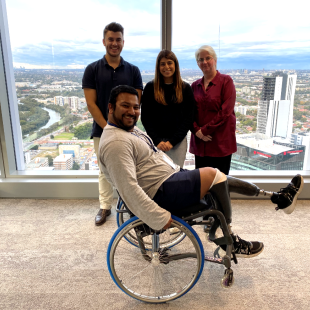Real life story – A passport to success
As Diversity and Inclusion Partner with the Department of Planning, Industry and Environment (DPIE), Dwayne’s role involves collaborating with all levels of the business to drive diversity, engaging at the executive level and with other managers.
“I am a person with two false legs but have never required adjustments in the workplace. However, within the first week of joining DPIE, a small wound on old scar tissue rendered me unable to use my prosthetics to walk and run. I went from having high mobility to low mobility, having to use my old wheelchair, and work remotely. This is where my workplace adjustment passport journey begins,” explained Dwayne.
After meeting his manager and the team, Dwayne collected his laptop on Day 1 and his remote working began. However, keen to start joining the team in the office, Dwayne went through DPIE’s workplace adjustment passport process. The online system asks questions about the employee’s disability and offers suggestions for adjustments, as well as outlining required supporting evidence and coordinating the approval process.
“At 11:07 am I filled out the online form and requested two adjustments, one major and one minor, being ongoing remote working and access to the office car park. By 1:19 pm I had confirmation that the major adjustment has been approved and implemented and by 3:15 pm the minor adjustments has been put in place. My response was wow, just wow - a formal process of workplace adjustment that is conducted with dignity and efficiency,” shared Dwayne.
Tiffany Auvaa (Manager WHS Projects), Alex Previtera (WHS Coordinator), PJ Hothi (Diversity & Inclusion Programs Manager) and Ann-Marie Mahony (Disability Employee Network Chair and Diversity Officer) were the working group championing and implementing the new workplace adjustments passport online portal process.
“One of the department’s key objectives to achieve in our Disability Inclusion Action Plan (DIAP) was to implement a workplace adjustment process. We wanted to make sure when rolling this out we had a world class approach, so we worked in collaboration with Tiffany and Alex to help deliver a solution to meet employee needs in looking for any type of adjustment due to physical attributes, disability, injury or illness, including both temporary and permanent conditions.
Collaboration was key for success. We consulted with the National Disability Recruitment Coordinator (NDRC), the DPIE disability community, our Harmony Council, People Partners and the Australian Disability Network to make sure we had universal consultation,” said PJ.
“It is led by and focuses on the individual, with an automated online process that produces a workplace adjustment passport they can take anywhere within the organisation. This means they do not need to repeat the process of applying for their adjustments, they only need to do it once or when there are required updates. The person requiring the adjustment is in complete control of it and how it is managed throughout their employment,” Alex states.
“Another key feature of the online portal is that the application goes directly to the Work Health and Safety team for action. This means decision-making comes from the individual in direct consultation with subject matter experts and has resulted in rapid implementation of workplace adjustments. It also takes the pressure off the individual’s manager in terms of a task they may not be familiar with and allows them more time to focus on their day-to-day responsibilities,” said Tiffany.
As part of their ongoing commitment to disability inclusion, DPIE is currently partnering with the National Disability Recruitment Coordinator (NDRC) – the employer engagement service at JobAccess. The NDRC works closely with large employers throughout Australia to improve their disability confidence through free, tailored 12-month partnerships. This involves a dedicated NDRC Professional Adviser working alongside an employer, to help identify and remove workplace barriers to disability employment and instil inclusive workplace practices.
“By partnering with the NDRC and the Australian Disability Network, we have enabled a safe and accessible workplace, and are therefore able to attract a wider audience of people with disability,” explained PJ.
Ann-Marie believes there are many benefits to be gained by a workplace adjustments system and had this advice for other employers considering embarking on a similar project.
“Consultation is crucial. Make sure you consult with all users and listen to your employee networks. In our case, they shaped the guidelines which outline everyone’s responsibilities. Communication is also important. Make sure the process is simplified, in plain English and there is a good communications plan and educational roll out. Most importantly, find a system and process that works for you and your people and that the decision-maker of the adjustment is the person with disability and the subject matter experts,” shared Ann-Marie.
According to Dwayne, while the recent wound injury may have affected his personal life, it did not affect his professional one. “When you acquire a disability, your personal life can be in disarray, so it’s fantastic to have a system to ensure career consistency and progression. My day-to-day job wasn’t affected.
“My advice to employers is that if you want to retain quality and engaged staff, you need to get these things right. Having this support to seamlessly manage the change (and within my very first week with DPIE) made me feel valued as an employee,” said Dwayne.
Funded by the Australian Government and delivered by industry professionals, JobAccess provides free and expert support to help remove barriers to employing people with disability. This includes an advice service, employer engagement team, and workplace modifications, support and training. Call 1800 464 800 to speak with a Professional Adviser.
Useful Downloads
Last updated:
